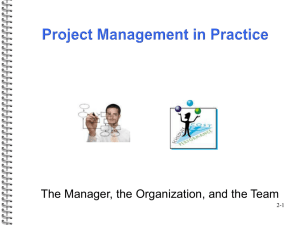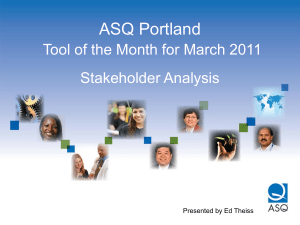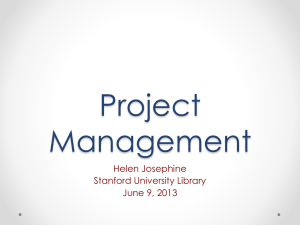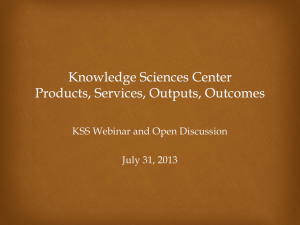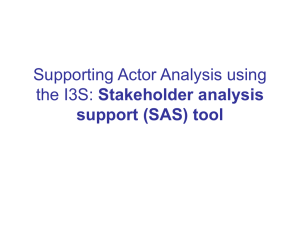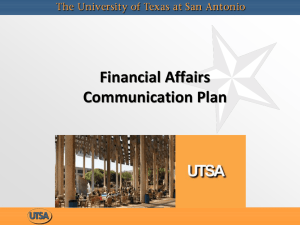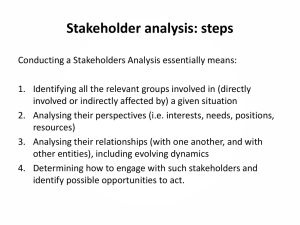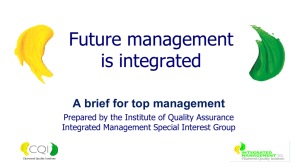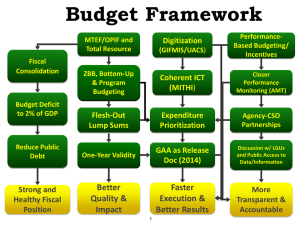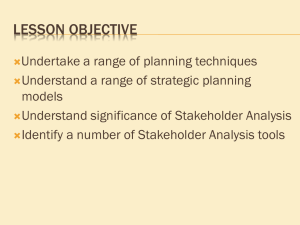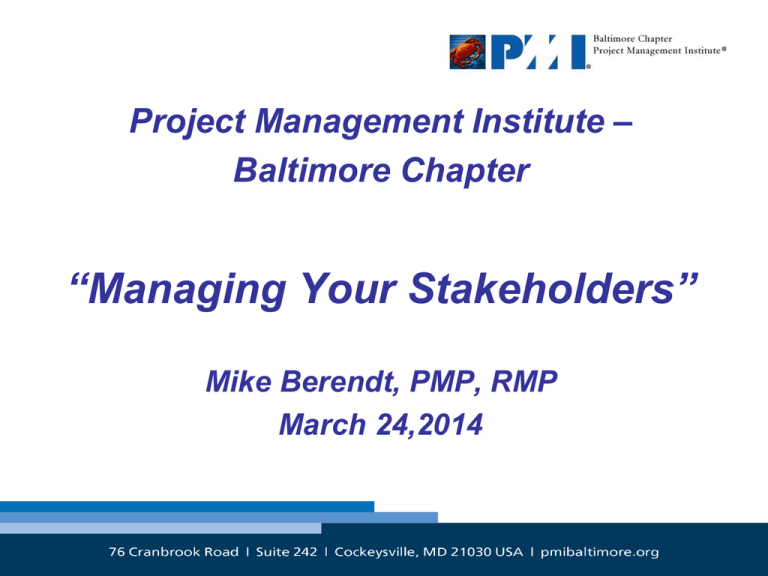
Project Management Institute –
Baltimore Chapter
“Managing Your Stakeholders”
Mike Berendt, PMP, RMP
March 24,2014
1
Acknowledgement
Thanks to Dr. James T. Brown for his
presentation at the PMI Leadership Institute
Meeting on 22 October 2012. His treatment of the
Art of Stakeholder Management provided the
inspiration for my own analysis. Dr. Brown is the
President of SEBA Solutions, a Registered
Education Provider for PMI.
Copyright © 2007 PMI BC – All Rights Reserved
2
Agenda
What does the PMBOK say?
How do we Manage our Stakeholders?
Identifying Stakeholders
Listening to Stakeholders
Focusing on the Customer
Dealing with Problem Stakeholders
Cultivating the Ideal Stakeholder
Copyright © 2007 PMI BC – All Rights Reserved
3
Project Stakeholder
Management
PMBOK Version 4
PMBOK Version 5
10.1 Identify Stakeholders
13.1 Identify Stakeholders
13.2 Plan Stakeholder Management
10.4 Manage Stakeholder
Expectations
13.3 Manage Stakeholder
Engagement
13.4 Control Stakeholder
Engagement
Copyright © 2007 PMI BC – All Rights Reserved
4
Chapter 13 Process Flow
Project
Charter
Stakeholder
Register
Identify
Stakeholders
Plan
Stakeholder
Management
Perform
Integrated
Change Control
Stakeholder
Management
Plan
Change
Control
Stakeholder
Engagement
Requests
Issue Log
Manage
Stakeholder
Engagement
Copyright © 2007 PMI BC – All Rights Reserved
5
From the PMBOK
PMBOK Process 13.1 Identify Stakeholders
“The process of identifying the people, groups, or
organizations that could impact or be impacted by a
decision, activity, or outcome of the project; and analyzing
and documenting relevant information regarding their
interests, involvement, interdependencies, influence, and
impact on project success.”
PMBOK, Fifth Edition, pg 391
Copyright © 2007 PMI BC – All Rights Reserved
6
From the PMBOK
PMBOK Process 13.3 Manage Stakeholder Engagement
“The process of communicating and working with
stakeholders to meet their needs/expectations, address
issues as they occur, and foster appropriate stakeholder
engagement in project activities throughout the project life
cycle.”
PMBOK, Fifth Edition, pg 391
Copyright © 2007 PMI BC – All Rights Reserved
7
PMBOK Stakeholders
Sponsor
Customers/Users
Sellers
Business Partners
Organizational Groups
Functional Managers
Other Stakeholders
Project Management Office
Other Project Managers
Project Team
PMBOK, Fifth Edition, pg 32-33
Copyright © 2007 PMI BC – All Rights Reserved
8
Power/Interest Grid
Used to Classify and Prioritize Stakeholders
High
Keep Satisfied
Manage Closely
(Maximum Effort)
Monitor
(Minimum Effort)
Keep Informed
Power
Low
High
Interest
PMBOK, Fifth Edition, pg 397
Copyright © 2007 PMI BC – All Rights Reserved
9
Tools and Techniques for
Managing Stakeholders
Understand Communication Methods
Formal/informal, upward/downward, lateral
Use appropriate method for each stakeholder
Utilize Interpersonal Skills (Appendix X3)
Build trust, active listening,
Resolve conflict, overcome resistance to change
Employ Effective Management Skills
Presentation Skills – oral and written
Negotiating with and among stakeholders
Use Issue Logs to document status and
outcomes on stakeholder requests
PMBOK, Fifth Edition, pg 407-408
Copyright © 2007 PMI BC – All Rights Reserved
10
Issue Logs
“A project document used to document and
monitor elements under discussion or in
dispute between project stakeholders”
Review the Issue Logs at each
Stakeholder meeting
PMBOK, Fifth Edition, pg 544
Copyright © 2007 PMI BC – All Rights Reserved
11
Issue Logs
Issue (Urgency/Impact)
Responsible Party (Owner)
Due Date for Resolution
Current Status
Issue Resolution
PMBOK, Fifth Edition, pg 281
Copyright © 2007 PMI BC – All Rights Reserved
12
Managing Stakeholder
Engagement – Other Ideas
Assess Stakeholder Power
Identify Stakeholders
Listen to Stakeholders
Handle the Problem Stakeholders
Build your credibility with the collective group
Minimize distractions to the project
Build Relationships with and between
Stakeholders
Cultivate Ideal Stakeholders
Build the cohesive, “Performing” Team
Copyright © 2007 PMI BC – All Rights Reserved
13
Identifying Stakeholders
Follow the Money! (Sponsor)
Who is paying or saving?
How do they feel about cost increases on the
project?
Follow the Resources! (Functional Mgrs.)
Who is providing people, equipment, or supplies?
External, Internal
What are their pain points?
Follow the Deliverables (Customer/User)
Who is the recipient of the product or services?
Do they need it perfect, on time, or within budget?
Where is the greatest risk to the project?
Copyright © 2007 PMI BC – All Rights Reserved
14
Identifying Stakeholders
Review the organizational chart
Ask your team members who they believe
carries the most weight on decisionmaking for
the project
Look for the unofficial people of influence
Most knowledgeable members of the team
Institutional knowledge (longest tenure)
Hardest, most diligent workers
Informal leaders
Copyright © 2007 PMI BC – All Rights Reserved
15
Listen to Your Stakeholders
Look for their pets:
Pet peeves
Pet projects
Pet people
Determine:
Their pain points
How their performance is evaluated
What they need to accomplish to have their boss
give them an “attaboy” or a promotion/raise
How do we make this project a “win” for most
of our stakeholders? (NOTE: You can’t
please all of the people all of the time!)
Copyright © 2007 PMI BC – All Rights Reserved
16
Listening Tips
Listen through the noise – what is the real
issue?
Distinguish between requirements and
solutions
Quality vs. quantity
Talking to more people doesn’t always clarify the
problem.
Look for the right people who can articulate the
issues and understand all viewpoints
Don’t react based on the first report – look for
hidden agendas
Copyright © 2007 PMI BC – All Rights Reserved
17
Focus on the Customer
Customer Satisfaction
“…a state of fulfillment in which the needs of a customer
are met or exceeded for the customer’s expected
experiences as assessed by the customer at the
moment of evaluation.”
We must not only “build it right”, we must “build the
right thing”
The longer the time frame to complete, the more
likely that the original customer need will change
PMBOK, Fifth Edition, pg 536
Copyright © 2007 PMI BC – All Rights Reserved
18
Customer Knowledge –
The Key Variable
“The Customer may not always be right, but
they are always the customer! “ USPS
“I have to build this system or deliver this
service, but I only have this much money”
The Government
“We have to develop it, prototype it, and get it
ready for market by 2nd Qtr or the competition
will get there first” Industry
“I don’t know what I want but I’ll know it when I
see it!” Your Customer
Copyright © 2007 PMI BC – All Rights Reserved
19
How to help your Customer
Let them know what to expect and what is expected of
them.
Restate what you heard him say and get the customer
to validate that is what he wants
Always take notes and provide minutes of customer
meetings (formal or informal)
Look for exceptions, gaps, or holes
Achieve consensus with the customer on capability
needs and requirements
Needs beget requirements beget solutions beget
deliverables – Requirements Traceability Matrix is KEY!
Copyright © 2007 PMI BC – All Rights Reserved
20
How to help your Customer
PMBOK Process 4.5 Perform Integrated Change
Control
“The process of reviewing all change requests;
approving changes and managing changes to
deliverables, …; and communicating their disposition”
Establish a Process and Enforce it!
Eliminate Scope Creep!
PMBOK, Fifth Edition, pg 63
Copyright © 2007 PMI BC – All Rights Reserved
21
Milestone Decisions
At each milestone in a project, you have three
possible decisions that affect how you deal with the
project going forward:
KEEP
MODIFY
CANCEL
Consider classifying your stakeholders in the same way
Copyright © 2007 PMI BC – All Rights Reserved
22
Problem Stakeholders
The Meddling Stakeholder
The Overbearing Stakeholder
The Poor Stakeholder
The Untrustworthy Stakeholder
The Indecisive Stakeholder
One or more of
these will
show up on
every project!
The Unavailable Stakeholder
Copyright © 2007 PMI BC – All Rights Reserved
23
Meddling Stakeholder
Develop “Rules of Engagement” for all stakeholders and
enforce them
Written or verbal
Document how often and what format will be used to
communicate with stakeholders (Plan Communications,
Stakeholder Management Strategy)
Assess the cause for the meddling
Does he not trust the Project Manager?
Will his experience help in any way?
If they insist on being involved, then involve them
Some Stakeholders are just Control Freaks – Keep them
informed and let them participate without taking over
Copyright © 2007 PMI BC – All Rights Reserved
24
Meddling Stakeholder
Develop “Rules of Engagement” for all stakeholders and
enforce them
Written or verbal
Document how often and what format will be used to
communicate with stakeholders (Plan Communications,
Stakeholder Management Strategy)
Assess the cause for the meddling
Does he not trust the Project Manager?
Will his experience help in any way?
If they insist on being involved, then involve them
Some Stakeholders are just Control Freaks – Keep them
informed and let them participate without taking over
Copyright © 2007 PMI BC – All Rights Reserved
25
Overbearing Stakeholder
Because of their position of power or personality,
they can be domineering and put the program at
risk
Make sure this stakeholder does not destroy
other project relationships or teamwork
Seek help with this one – look for another
stakeholder of equal power to neutralize this one
Build the team – Build a “Performing”
organization that tolerates but largely ignores the
overbearing stakeholder – Let them have their
say but do what the group decides
Copyright © 2007 PMI BC – All Rights Reserved
26
Overbearing Stakeholder
Because of their position of power or personality,
they can be domineering and put the program at
risk
Make sure this stakeholder does not destroy
other project relationships or teamwork
Seek help with this one – look for another
stakeholder of equal power to neutralize this one
Build the team – Build a “Performing”
organization that tolerates but largely ignores the
overbearing stakeholder – Let them have their
say but do what the group decides
Copyright © 2007 PMI BC – All Rights Reserved
27
Poor Stakeholder
Has interests and is impacted by the project but
has no significant budget authority
May play politics in order to gain influence
Understand his objectives
Do they line up or conflict with more powerful
stakeholders?
How do we leverage opportunities with him?
His opinions may be a predictor of future issues
Copyright © 2007 PMI BC – All Rights Reserved
28
Poor Stakeholder
Has interests and is impacted by the project but
has no significant budget authority
May play politics in order to gain influence
Understand his objectives
Do they line up or conflict with more powerful
stakeholders?
How do we leverage opportunities with him?
His opinions may be a predictor of future issues
Copyright © 2007 PMI BC – All Rights Reserved
29
Untrustworthy Stakeholder
Plays both sides, won’t stand by his word,
refuses to document anything with a signature
Root cause may be fear of accountability,
inexperience, or ignorance
Team must document all important
communication
Solid Communication Plan
Document decisions (Minutes and Action Items)
Keep a record of his behavior
Take Proactive action or partner with others
Watch what you say – It may come back to you!
Copyright © 2007 PMI BC – All Rights Reserved
30
Untrustworthy Stakeholder
Plays both sides, won’t stand by his word,
refuses to document anything with a signature
Root cause may be fear of accountability,
inexperience, or ignorance
Team must document all important
communication
Solid Communication Plan
Document decisions (Minutes and Action Items)
Keep a record of his behavior
Take Proactive action or partner with others
Watch what you say – It may come back to you!
Copyright © 2007 PMI BC – All Rights Reserved
31
Indecisive Stakeholder
Can never make decisions in a timely manner;
does not remain committed to previous decisions
Set up processes and structures that clearly
communicate when the decision is required and
the impact of delays
Milestones on Schedules
Capture lost time/money due to delayed decisions
Action Logs and suspenses
What would your boss say if he knew that your inaction
was the primary reason the project could not deliver?
Copyright © 2007 PMI BC – All Rights Reserved
32
Indecisive Stakeholder
Can never make decisions in a timely manner;
does not remain committed to previous decisions
Set up processes and structures that clearly
communicate when the decision is required and
the impact of delays
Milestones on Schedules
Capture lost time/money due to delayed decisions
Action Logs and suspenses
What would your boss say if he knew that your inaction
was the primary reason the project could not deliver?
Copyright © 2007 PMI BC – All Rights Reserved
33
Unavailable Stakeholder
Always “too busy” to participate when their input
or approval is required
Usually the ones that question decisions or
challenge deliverables at pivotal points because
they become involved at the last minute
Never available to help but always available to
critique the result
Copyright © 2007 PMI BC – All Rights Reserved
34
Unavailable Stakeholder
Always “too busy” to participate when their input
or approval is required
Usually the ones that question decisions or
challenge deliverables at pivotal points because
they become involved at the last minute
Never available to help but always available to
critique the result
Copyright © 2007 PMI BC – All Rights Reserved
35
Unavailable Stakeholder
Strategies
Keep a detailed log of efforts made to
communicate with this stakeholder
Get them to delegate authority to someone they
trust to represent them
Eliminate the excuses
Maintain scheduled meetings and timeframes that do not
conflict with other events
Publish schedules and topics well in advance and follow
up with email and phone reminders
Find a way to include them without their physical
presence – Telecon, video-conferences, webinars
One-on-one contact for important decisions – visit them
personally (respect their power)
Copyright © 2007 PMI BC – All Rights Reserved
36
The Ideal Stakeholder
Shows an interest in the project
Makes themselves available when necessary
Assigns qualified personnel to act on their
behalf when they are away
Are willing to be held accountable
Reviews and signs documents in a timely
manner
Copyright © 2007 PMI BC – All Rights Reserved
37
The Ideal Stakeholder (cont)
Prioritizes their requirements
Tells you how best to communicate with them
Doesn’t pressure the Project Manager to
circumvent the management prcesses
Looks for opportunities to assist the project
team
Helps motivate key personnel by showing their
appreciation for the project work
Copyright © 2007 PMI BC – All Rights Reserved
38
The Ideal Stakeholder (cont)
Prioritizes their requirements
Tells you how best to communicate with them
Doesn’t pressure the Project Manager to
circumvent the management processes
Looks for opportunities to assist the project
team
Helps motivate key personnel by showing their
appreciation for the project work
Copyright © 2007 PMI BC – All Rights Reserved
39
Closing Thoughts
May all your stakeholders be the
Ideal Stakeholder!
However, this is the exception and not the
rule, so use your Stakeholder Register and
Issue Logs to Manage all of your
Stakeholders’ expectations, meticulously
documenting their concerns and how you
addressed them.
Copyright © 2007 PMI BC – All Rights Reserved
40
Questions???
Mike Berendt, PMP, RMP
Columbia Site Director
410-908-6777
Mike.Berendt@pmibaltimore.org
41

